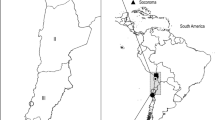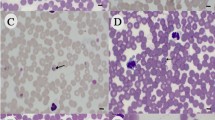Abstract
Babesia bovis and Babesia bigemina are distributed all over the world; the etiologic agents of the animal babesiosis are considered the most important tick-borne disease. The present research work was the first attempt to determine the prevalence of B. bovis and B. bigemina infection in ticks, in Egypt, by using polymerase chain reaction (PCR). Questing 5,243 hard and soft ticks were collected from different localities throughout the Giza Governorate. Furthermore, DNA from 500 different individual tick species was extracted and PCR was performed. Primers verified from the sequence of Mexico strain of both species were used. Two fragments of 275 and 175 bp of B. bovis and B. bigemina, respectively, were generated. Fragments of the pathogens were recovered with PCR and sequenced. The prevalence of B. bovis and B. bigemina in Boophilus annulatus ticks were 55% and 66%, respectively. Also, presence of 12% dual infection with B. bovis and B. bigemina was observed. Sequence analysis of PCR product of these pathogens shares a high degree of similarity in sequence compared to similar species found in GenBank.









Similar content being viewed by others
References
Abd-El Gawad M (1993) Some studies on Babesia species in cattle in Beni-Suef governorate. Ph.D. Thesis, Fac. Vet. Med., Cairo Univ., Giza, Egypt
Abo-Elkheir EA (1989) Epidemiological aspect on the distribution of haemotrophic parasites among cattle in Upper Egypt confirmed by the identification of encountered organisms. M.Sc. Thesis, Fac. Vet. Med., Cairo Univ., Giza, Egypt
Ahmed AB (1980) Some biological studies on blood parasites of farm animals. Ph.D. Thesis, Fac. Vet. Med., Zagazig Univ., Zagazig, Egypt
Altschul SF, Madden TL, Schäfferl AA, Zhang J, Zheng Z, Miller W, Lipman DJ (1997) Gapped BLAST and PSI-BLAST: a new generation of protein database search programs. Nucleic Acids Res 25:3389–3402
Calder JA (1994) Improved diagnosis of bovine babesiosis. Ph.D. Thesis, Fac. Vet. Med. Florida Univ., Gainesville, FL, USA
Chafick ML (1987) Serological tests for the field diagnosis of Babesia infection in claves. M.Sc. Thesis, Fac. Vet. Med., Cairo Univ., Cairo, Egypt
Drummond RO, George JE, Kunz SE (ed) (1988) Control of arthropod pests of livestock. Rev. Tech., CRC Press, Boca Raton, pp 1–19 and 145–158
El-Allawy TA (1973) Some studies on bovine piroplasmosis in Assiut. M.Sc. Thesis, Fac. Vet. Med., Assiut Univ., Assiut, Egypt
El-Ghaysh AA (1993) Studies on Babesia sp. infecting cattle and water buffaloes in Egypt. Ph.D. Thesis, Fac. Vet. Med., Cairo Univ. Giza, Egypt
Fadly RS (1996) Serological studies on Babesia in Behera Province M.Sc. Thesis, Fac. Vet. Med. Alexandria Univ. Alexandria, Egypt
Fahrimal Y, Goff WL, Jasmer DP (1992) Detection of Babesia bovis carrier cattle by using polymerase chain reaction amplification of parasite DNA. J Clin Microbiol 30:2091–2096
Figueroa JV, Chieves LP, Johnson GS, Buening GM (1993) Multiplex polymerase chain reaction based assay for detection of Babesia bigemina, Babesia bovis and Anaplasma marginale DNA in bovine blood. Vet Parasitol 50:69–81
Gattas MW (1983) Some studies on cattle Babesiosis in Suez Canal zone. M.Sc. Thesis, Fac. Vet. Med., Cairo Univ., Giza, Egypt
Gattas MW (1990) Further studies on the biological aspect of Babesia species in Suez Canal zone with special references to their control. Ph.D. Thesis, Cairo Univ., Giza, Egypt
Higgins JA, Azad AF (1995) Use of polymerase chain reaction to detect bacteria in arthropods: a review. J Med Entomol 32:213–222
Hoogstraal H (1981) Changing patterns of tick borne diseases in modern society. Ann Rev Entomol 26:75–99
Mahoney DF (1969) Bovine babesiosis: a study of factors concerned in transmission. Ann Trop Parasitol 63:1–14
Martins TM, Pedro OC, Caldeira RA, Do Rosário VE, Neves L, Domingos A (2008) Detection of bovine babesiosis in Mozambique by a novel seminested hot-start PCR method. Vet Parasitol 153:225–230
Mohan RN (1968) Diseases and parasites of buffaloes. Vet Bull 38:647–659
Morzaria S, Katende J, Kairo A, Nene V, Musoke A (1992) New methods for the diagnosis of Babesia bigemina infection. Mem Inst Oswaldo Cruz Rio J 87(Suppl 3):201–205
Nagati HE (1947) Some new and rare records of piroplasmosis with a list of the species of Babesia and Theileria so far recorded from Egypt. Vet Rec 59:145–147
Oliveira-Sequeira TCG, Oliveira MCS, Araujo JP, Amarante AFT (2005) PCR-based detection of Babesia bovis and Babesia bigemina in their natural host Boophilus microplus and cattle. Int J Parasitol 35:105–111
Reddy GR, Charkarbari D, Yowell CA, Dame JB (1991) Sequence microheterogeneity of the three small subunit ribosomal RNA genes of B. bigemina expression in erythrocyte culture. Nucleic Acids Res 19:3641–3645
Roberts LS, Janovy J (2005) Foundations of parasitology, 7th edn. McGraw Hill, New York, pp 644–646
Saiki RK, Gelfand DH, Stoffel S, Scharf SJ, Higuchi R, Horn GT, Mullis KB, Erlich HA (1988) Primer-directed enzymatic amplification of DNA with a thermostable DNA polymerase. Science 23:488–491
Sakla AA (1975) Studies on ticks in Assiut Governorate, with special reference to their role in transmission of parasitic diseases. M.Sc. Thesis, Fac. Vet. Med., Assiut Univ., Assiut, Egypt
Salem GH (1998) Using of ribosomal DNA based PCR method for sensitive detection of carrier and mild babesial infection among cattle in Egypt. Assiut Vet Med J 39:92–108
Sambrook J, Fritsch EF, Maniatis T (1989) Molecular cloning: a laboratory manual. Cold Spring Harbor Laboratory Press, Cold Spring Harbor
Todorovic RA (1975) Serological diagnosis of babesiosis: a review. Trop Anim Health Prod 7:1–14
Wall R, Shearer D (ed) (1997) Veterinary entomology. Chapman and Hall, London, pp 97–140 and 132–133
Waters AP, McCutchan TF (1990) Ribosomal RNA, nature’s own polymerase-amplified target for diagnosis. Parasit Today 6:56–59
Weiland G, Reiter I (1988) Methods for measurement of the serological response to Babesia. In: Ristic M (ed) Babesiosis of domestic animals and man. CRC Press, Boca Raton, pp 143–162
Wittenbrink MM, Thiele D, Krauss H (1994) Comparison of dark-field microscopy, culture, and polymerase chain reaction (PCR) for detection of Borrelia burgdorferi in field-collected Ixodes ricinus ticks. Zentralbl Bakteriol 281:183–191
Zhang M, Gothe R, Rinder H (1995) Detection of spotted fever group rickettsiae in ticks and rodents by PCR technique in People’s Republic of China. Acta Virol 39:263–267
Author information
Authors and Affiliations
Corresponding author
Rights and permissions
About this article
Cite this article
Adham, F.K., Abd-El-Samie, E.M., Gabre, R.M. et al. Detection of tick blood parasites in Egypt using PCR assay I—Babesia bovis and Babesia bigemina . Parasitol Res 105, 721–730 (2009). https://doi.org/10.1007/s00436-009-1443-8
Received:
Accepted:
Published:
Issue Date:
DOI: https://doi.org/10.1007/s00436-009-1443-8




